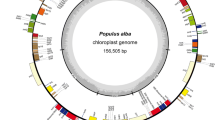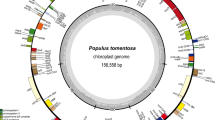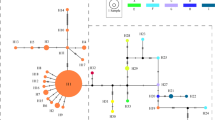Abstract
The wild common bean (Phaseolus vulgaris) is widely but discontinuously distributed from northern Mexico to northern Argentina on both sides of the Isthmus of Panama. Little is known on how the species has reached its current disjunct distribution. In this research, chloroplast DNA polymorphisms in seven non-coding regions were used to study the history of migration of wild P. vulgaris between Mesoamerica and South America. A penalized likelihood analysis was applied to previously published Leguminosae ITS data to estimate divergence times between P. vulgaris and its sister taxa from Mesoamerica, and divergence times of populations within P. vulgaris. Fourteen chloroplast haplotypes were identified by PCR-RFLP and their geographical associations were studied by means of a Nested Clade Analysis and Mantel Tests. The results suggest that the haplotypes are not randomly distributed but occupy discrete parts of the geographic range of the species. The current distribution of haplotypes may be explained by isolation by distance and by at least two migration events between Mesoamerica and South America: one from Mesoamerica to South America and another one from northern South America to Mesoamerica. Age estimates place the divergence of P. vulgaris from its sister taxa from Mesoamerica at or before 1.3 Ma, and divergence of populations from Ecuador-northern Peru at or before 0.6 Ma. As these ages are taken as minimum divergence times, the influence of past events, such as the closure of the Isthmus of Panama and the final uplift of the Andes, on the migration history and population structure of this species cannot be disregarded.
Similar content being viewed by others
References
Avise J. C., Arnold J., Ball R. M., Bermingham E., Lamb T., Neigel J. E., Reeb C. A. and Saunders N. C. (1987). Intraspecific phylogeography: the mitochondrial DNA bridge between population genetics and systematics. Annual Rev. Ecol. Syst. 18: 489–522
Becerra Velásquez V. L. and Gepts P. (1994). RFLP diversity of common bean (Phaseolus vulgaris) in its centers of origin. Genome 37: 256–263
Berglund-Brücher O. and Brücher H. (1976). The South American wild bean (Phaseolus aborigineus Burk.) as ancestor of the common bean. Econ. Bot. 30: 257–272
Beebe S., Toro C. O., González A. V., Chacon M. I. and Debouck D. G. (1997). Wild-weed-crop complexes of common bean (Phaseolus vulgaris L., Fabaceae) in the Andes of Peru and Colombia, and their implications for conservation and breeding. Genet. Res. Crop Evol. 44: 73–91
Burnham R. J. and Graham A. (1999). The history of neotropical vegetation: new developments and status. Ann. Missouri Bot. Gard. 86: 546–589
Chacón S. M. I., Pickersgill B. and Debouck D. G. (2005). Domestication patterns in common bean (Phaseolus vulgaris L.) and the origin of the Mesoamerican and Andean cultivated races. Theor. Appl. Genet. 110: 432–444
Coates A. G. (1997). The forging of Central America. In: Coates, A. G. (eds) Central America: a natural and cultural history, pp 1–37. Yale University Press, New Haven and London
Coates A. G., Collins L. S., Aubry M. P. and Berggren W. A. (2004). The geology of the Darien, Panama, and the late Miocene-Pliocene collision of the Panama arc with northwestern South America. Geol. Soc. Amer. Bull. 2004 116: 1327–1344
Debouck D. (1991) Systematics and morphology, in: van Schoonhoven A., Voysest O. (eds.) Common beans: Research for crop improvement, Commonwealth Agricultural Bureaux International, Wallingford, United Kingdom, pp. 55–118.
Debouck D. G., Toro O., Paredes O. M., Johnson W. C. and Gepts P. (1993). Genetic diversity and ecological distribution of Phaseolus vulgaris (Fabaceae) in northwestern South America. Econ. Bot. 47: 408–423
Delgado-Salinas A., Turley T., Richman A. and Lavin M. (1999). Phylogenetic analysis of the cultivated and wild species of Phaseolus (Fabaceae). Syst. Bot. 24: 438–460
Demesure B., Sodzi N. and Petit R. J. (1995). A set of universal primers for amplification of polymorphic non-coding regions of mitochondrial and chloroplast DNA in plants. Molec. Ecol. 4: 129–131
Dick C. E., Abdul-Salim K. and Bermingham E. (2003). Molecular systematic analysis reveals cryptic tertiary diversification of a widespread tropical rainforest tree. Amer. Naturalist 162: 691–703
Excoffier L. and Smouse P. (1994). Using allele frequencies and geographic subdivision to reconstruct gene genealogies within a species: molecular variance parsimony. Genetics 136: 343–359
Ferrusquía-Villafranca I. (1993). Geology of Mexico: A sypnosis. In: Ramamoorthy, T. P., Bye, R., Lot, A. and Fa, J. E. (eds) Biological diversity of Mexico: Origins and distribution, pp 3–107. Oxford University Press, New York
Freyre R., Ríos R., Guzmán L., Debouck D. G. and Gepts P. (1996). Ecogeographic distribution of Phaseolus spp. (Fabaceae) in Bolivia. Econ. Bot. 50: 195–215
Freytag G. F. and Debouck D. G. (1996). Phaseolus costaricensis, a new wild species (Phaseolinae, Leguminosae) from Costa Rica and Panama, Central America. Novon 6: 157–163
Freytag G. F., Debouck D. G. (2002) Taxonomy, distribution, and ecology of the genus Phaseolus (Leguminosae-Papilionoideae) in North America, Mexico and Central America Botanical Research Institute of Texas (BRIT) Forth Worth, TX, USA 298.
Gentry A. H. (1982). Neotropical floristic diversity: phytogeographical connections between Central and South America, Pleistocene climatic fluctuations, or an accident of the Andean orogeny? Ann. Missouri Bot. Gard. 69: 557–593
Gepts P. and Bliss F. A. (1985). F1 hybrid weakness in the common bean. Differential geographic origin suggests two gene pools in cultivated bean germplasm. J. Heredity 76: 447–450
Gepts P., Osborn T. C., Rashka K. and Bliss F. A. (1986). Phaseolin-protein variability in wild forms and landraces of the common bean (Phaseolus vulgaris): evidence for multiple centers of domestication. Econ. Bot. 40: 451–468
Gepts P. (1988). Phaseolin as an evolutionary marker. In: Gepts, P. (eds) Genetic resources of Phaseolus Beans, pp 215–241. Kluwer Academic Publishers, Dordrecht, Netherlands
Gepts P., Papa R., Coulibaly S., Gonzalez Mejía A., Pasquet R. (1999) Wild legume diversity-insights from molecular methods. In: Ministry of Agriculture, Forestry and Fisheries (MAFF) International Workshop on Genetic Resources, National Institute of Agrobiological Resources Tsukuba, Ibaraki, Japan, pp. 19–31.
Goloboff P. A. and Pol D. (2005). Parsimony and Bayesian phylogenetics. In: Albert, V. A. (eds) Parsimony, phylogeny and genomics, pp 148–162. Oxford University Press, Ed.Victor A. Albert
Graham A. (1993). Historical factors and biological diversity in Mexico. In: Ramamoorthy, T. P., Bye, R., Lot, A. and Fa, J. E. (eds) Biological diversity of Mexico, pp 109–127. Oxford University Press, New York
Guerrero J. (1997). Stratigraphy, sedimentary environments and the Miocene uplift of the Colombian Andes. In: Kay, R. F., Madden, R. H., Cifelli, R. L., and Flynn, J. J. (eds) Vertebrate palaeontology in the Neotropics, pp 15–43. Smithsonian Institution Press, Washington, D.C.
Gutiérrez Salgado A., Gepts P. and Debouck D. G. (1995). Evidence for two gene pools of the lima bean, Phaseolus lunatus L., in the Americas. Genet. Res. Crop. Evol. 42: 15–28
Heads M. (2005). Dating nodes on molecular phylogenies: a critique of molecular biogeography. Cladistics 21: 62–78
Jones P. G., Beebe S. and Tohme J. (1997). The use of geographical information systems in biodiversity exploration and conservation. Biodlivers. Conserv. 6: 947–958
Kami J., Becerra Velásquez V., Debouck D. G. and Gepts P. (1995). Identification of presumed ancestral DNA sequences of phaseolin in Phaseolus vulgaris. Proc. Natl. Acad. Sci. USA 92: 1101–1104
Khairallah M. M., Sears B. B. and Adams M. W. (1992). Mitochondrial restriction fragment length polymorphisms in wild Phaseolus vulgaris L.: insights on the domestication of the common bean. Theor. Appl. Genet. 84: 915–922
Koenig R. L., Singh S. P. and Gepts P. (1990). Novel phaseolin types in wild and cultivated common bean (Phaseolus vulgaris, Fabaceae). Econ. Bot. 44: 50–60
Lavin M., Herendeen P. S. and Wojciechowski M. F. (2005). Evolutionary rates analysis of Leguminosae implicates a rapid diversification of lineages during the Tertiary. Syst. Biol. 54: 575–594
Marshall C. J. and Liebherr J. K. (2000). Cladistic biogeography of the Mexican transition zone. J. Biogeogr. 27: 203–216
Nei M. (1987). Molecular evolutionary genetics. Columbia University Press, New York
Nylander J. A. A. (2004). MrModeltest v2. Program distributed by the author. Evolutionary Biology Centre, Uppsala University
Pennington R. T. and Dick C. W. (2004). The role of immigrants in the assembly of the South American rainforest flora. Phil. Trans. Roy. Soc. B 359: 1611–1622
Pickersgill B. and Heiser C. B. (1977). Origins and distribution of plants domesticated in the New World tropics. In: Reed, C. A. (eds) Origins of agriculture, pp 803–835. Mouton Publishers, Paris
Pirie M. D., Chatrou L. W., Mols J. B., Erkens R. H. J. and Oosterhof J. (2006). Andean-centred genera in the short-branch clade of Annonaceae: testing biogeographical hypotheses using phylogeny reconstruction and molecular dating. J Biogeogr. 33: 31–46
Posada D., Crandall K. A. and Templeton A. R. (2000). GeoDis: a program for the cladistic nested analysis of the geographical distribution of genetic haplotypes. Molec. Ecol. 9: 487–488
Ronquist F., Huelsenbeck J. P., van der Mark P. (2005) Mr. Bayes, published by authors. Available at: http://mrbayes.net.
Sanderson M. J. (2002). Estimating absolute rates of molecular evolution and divergence times: a penalized likelihood approach. Molec. Biol. Evol. 19: 101–109
Sanderson M. J. (2004) r8s 1.70 Analysis of rates (``r8s'') of evolution. Available at http://ginger.ucdavis.edu/r8s/.
Schmit V. and Debouck D. G. (1991). Observations on the origin of Phaseolus polyanthus Greenman. Econ. Bot. 45: 345–364
Schmit V., du Jardin P., Baudoin J. P. and Debouck D. G. (1993). Use of chloroplast DNA polymorphisms for the phylogenetic study of seven Phaseolus taxa including P. vulgaris and P. coccineus. Theor. Appl. Genet. 87: 506–516
Schneider S., Roessli D., Excoffier L. (2000) Arlequin ver. 2000: A software for population genetics data analysis, 2.000 ed. Genetics and Biometry Laboratory, University of Geneva, Switzerland, Geneve.
Simpson B. B. (1975). Pleistocene changes in the flora of the high tropical Andes. Paleobiology 1: 273–294
Smith B. D. (1995) The emergence of agriculture. Scientific American Library New York 231.
Soltis D. E., Soltis P. S. and Milligan B. J. (1992). Intraspecific chloroplast DNA variation: systematic and phylogenetic implications. In: Soltis, P. S., Soltis, D. E., and Doyle, J. J. (eds) Molecular systematics of plants, pp 117–150. Chapman & Hall, New York
Swofford D. L. (1998). Phylogenetic Analysis Using Parsimony, version 4.0. Sinauer associates, Sunderland (USA)
Taberlet P., Gielly L., Pautou G. and Bouvet J. (1991). Universal primers for amplification of three non-coding regions of chloroplast DNA. Pl. Molec. Biol. 17: 1105–1109
Templeton A. R., Boerwinkle E. and Sing C. F. (1987). A cladistic analysis of phenotypic associations with haplotypes inferred from restriction endonuclease mapping. I. Basic theory and an analysis of alcohol dehydrogenase activity in Drosophila. Genetics 117: 343–351
Templeton A. R. and Sing C. F. (1993). A cladistic analysis of phenotypic associations with haplotypes inferred from restriction endonuclease mapping. IV. Nested analysis with cladogram uncertainty and recombination. Genetics 134: 659–669
Templeton A. R., Routman E. and Phillips C. A. (1995). Separating population structure from population history: a cladistic analysis of the geographical distribution of mitochondrial DNA haplotypes in the tiger salamander, Ambystoma tigrinum. Genetics 140: 767–782
Templeton A. R. (1998). Nested clade analyses of phylogeographic data: testing hypotheses about gene flow and population history. Molec. Ecol. 7: 381–397
Tohme J., Orlando González D., Beebe S. and Duque M. C. (1996). AFLP analysis of gene pools of a wild bean core collection. Crop Sci. 36: 1375–1384
Toro O., Tohme J., Debouck D. G. (1990) Wild bean (Phaseolus vulgaris L.): description and distribution Centro Internacional de Agricultura Tropical Cali, Colombia 106.
Webb S. D. (1997). The great American faunal interchange. In: Coates, A. G. (eds) Central America: a natural and cultural history, pp 97–122. Yale University Press, Michigan
Wheeler W. C. (1996). Optimization alignment: the end of multiple sequence alignment in phylogenetics? Cladistics 12: 1–9
Wheeler W. C. (2003). Implied Alignment: A synapomorphy-based mulitple sequence alignment method. Cladistics 19: 261–268
Wheeler W. C., Gladtein D. S., DeLaet J. (2003) Poy 3.0, American Museum of Natural History. Available on: ftp://ftp.amnh.org/pub/molecular/poy.
Young K. R., Ulloa Ulloa C. and Luteyn J. L. (2002). Plant evolution and endemism in Andean South America: an introduction. Bot. Rev. 68: 4–21
Author information
Authors and Affiliations
Corresponding author
Rights and permissions
About this article
Cite this article
Chacón S., M., Pickersgill, B., Debouck, D. et al. Phylogeographic analysis of the chloroplast DNA variation in wild common bean (Phaseolus vulgaris L.) in the Americas. Plant Syst. Evol. 266, 175–195 (2007). https://doi.org/10.1007/s00606-007-0536-z
Received:
Accepted:
Published:
Issue Date:
DOI: https://doi.org/10.1007/s00606-007-0536-z




